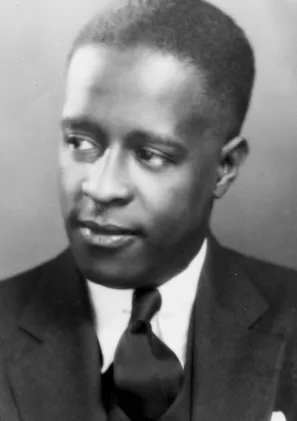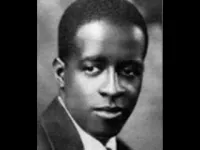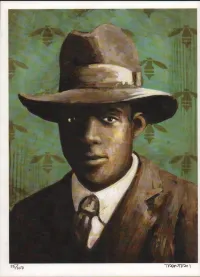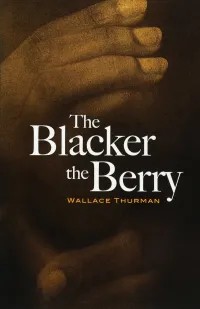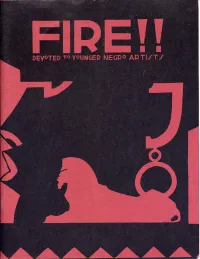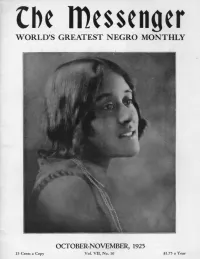Biography
1902 - 1934
“Being a Negro writer these days is a racket and I'm going to make the most of it while it lasts. About twice a year I sell a story. It is acclaimed. I am a genius in the making. Thank God for this Negro literary renaissance. Long may it flourish."
- Wallace Thurman
Wallace Thurman was born in Salt Lake City. During his troubled and unstable childhood, he found solace in reading and wrote his first novel at 10. He began as a pre-med student at the University of Utah, but transferred to USC in Los Angeles. Instead of earning his degree, he left academia to become a reporter and columnist for a black owned newspaper. He began the magazine ‘Outlet,’ which was intended to be the West Coast equivalent of the NAACP’s ‘Crisis’ periodical. In 1925 Thurman moved to New York and became an integral part of the Harlem Renaissance – a broad cultural movement of African American artists, singers, writers and performers who had migrated to New York. There he worked as an editor and publisher, while writing plays, novels, and essays as well. In 1926 he became editor of ‘The Messenger,’ a socialist journal for blacks, where he was the first to publish the adult-themed stories of Langston Hughes. That same year he collaborated in founding the literary magazine ‘Fire!’ which challenged the notion that black art should be a form of propaganda for white approval, claiming instead that black art should reveal the reality of African American life. Thurman’s apartment at 267 West 136th Street, its walls adorned with Richard Bruce Nugent’s homoerotic murals, became the cultural meeting place of this new black artistic movement. In 1928 Thurman edited the magazine ‘Harlem: A Forum of Negro Life.’ That same year he married Louise Thompson, who soon sought a divorce claiming Thurman was closeted homosexual and their union incompatible. Thurman, the first African-American reader for a major publishing house, is best known for his work The Blacker the Berry: A Novel of Negro Life (1929) which explored discrimination based on skin tone within the black community. Later that year his play, ‘Harlem,’ debuted on Broadway. In 1932 he published The Infants of Spring, a satire of the themes and personalities of the Harlem Renaissance and also co-wrote the book The Interne. Thurman died in 1934 from tuberculosis exacerbated by alcoholism.
1902 - 1934
“Being a Negro writer these days is a racket and I'm going to make the most of it while it lasts. About twice a year I sell a story. It is acclaimed. I am a genius in the making. Thank God for this Negro literary renaissance. Long may it flourish."
- Wallace Thurman
Wallace Thurman was born in Salt Lake City. During his troubled and unstable childhood, he found solace in reading and wrote his first novel at 10. He began as a pre-med student at the University of Utah, but transferred to USC in Los Angeles. Instead of earning his degree, he left academia to become a reporter and columnist for a black owned newspaper. He began the magazine ‘Outlet,’ which was intended to be the West Coast equivalent of the NAACP’s ‘Crisis’ periodical. In 1925 Thurman moved to New York and became an integral part of the Harlem Renaissance – a broad cultural movement of African American artists, singers, writers and performers who had migrated to New York. There he worked as an editor and publisher, while writing plays, novels, and essays as well. In 1926 he became editor of ‘The Messenger,’ a socialist journal for blacks, where he was the first to publish the adult-themed stories of Langston Hughes. That same year he collaborated in founding the literary magazine ‘Fire!’ which challenged the notion that black art should be a form of propaganda for white approval, claiming instead that black art should reveal the reality of African American life. Thurman’s apartment at 267 West 136th Street, its walls adorned with Richard Bruce Nugent’s homoerotic murals, became the cultural meeting place of this new black artistic movement. In 1928 Thurman edited the magazine ‘Harlem: A Forum of Negro Life.’ That same year he married Louise Thompson, who soon sought a divorce claiming Thurman was closeted homosexual and their union incompatible. Thurman, the first African-American reader for a major publishing house, is best known for his work The Blacker the Berry: A Novel of Negro Life (1929) which explored discrimination based on skin tone within the black community. Later that year his play, ‘Harlem,’ debuted on Broadway. In 1932 he published The Infants of Spring, a satire of the themes and personalities of the Harlem Renaissance and also co-wrote the book The Interne. Thurman died in 1934 from tuberculosis exacerbated by alcoholism.
Demography
Demography
Gender Male
Sexual Orientation Gay
Gender Identity Cisgender
Ethnicity African American Black
Nations Affiliated United States
Era/Epoch Harlem Renaissance (1919-1929)
Field(s) of Contribution
Author
Journalism
Demography
Gender Male
Sexual Orientation Gay
Gender Identity Cisgender
Ethnicity African American Black
Nations Affiliated United States
Era/Epoch Harlem Renaissance (1919-1929)
Field(s) of Contribution
Author
Journalism
